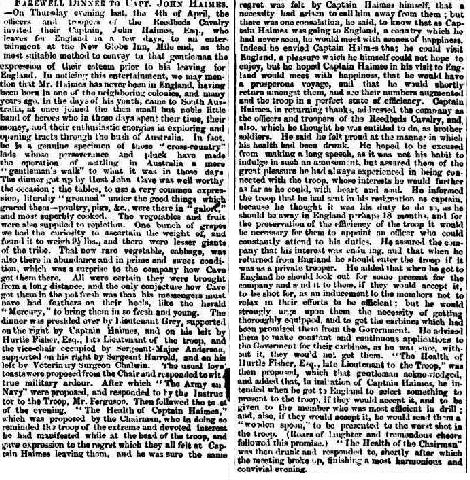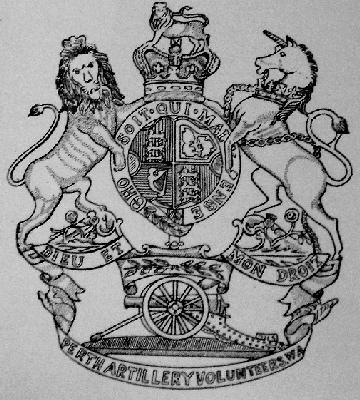Topic: Militia - LHS - SA
South Australian Militia - 1861
Reedbeds Cavalry and Captain John Haimes

The artilce is transcribed below:
FAREWELL DINNER TO CAPT. JOHN HAIMES.
On Thursday evening last, the 11th of April, the officers and troopers of the Reedbeds Cavalry invited their Captain, John Haimes, Esq., who leaves for England in a few days, to an entertainment at the New Globe Inn, Mile end, as the most suitable method to convey to that gentleman the expression of their esteem prior to his leaving for England. In noticing this entertainment, we may mention that Mr Haimes has never been in England, having been born in one of the neighbouring colonies, and many years ago in the days of his youth came to South Australia, at once joined the then small but noble little band of heroes who in those days spent their time, their money, and the enthusiastic energies exploring and opening tracts through the bush of Australia. In fact he is a genuine specimen of those ''cross country" lads whose perseverance and pluck have made the operation of settling in Australia, a mere "gentleman's walk" to what it was in those days.
The dinner got up by Host John Cave was well worthy the occasion; the tables to use a very common expression, literally "groaned" under the good things which graced them - poultry, pigs, &.c were there in "galore" and most superbly cooked. The vegetables and fruit were also supplied to repletion. One bunch of grapes we had the curiosity to ascertain the weight of, and found it to weigh 9½ lbs., and there were other lesser giants of the tribe. That now rare vegetable, cabbage, was also there in abundance and in prime and sweet condition, which was a surprise to the company how Cave got them there All were certain they were brought from a long distance, and the only conjecture how Cave got them in the pot fresh was that his messengers must have had feathers on their heels, like the herald "Mercury", to bring them in so fresh and young. The dinner was presided over by Lieutenant Grey, supported on the right by Captain Haimes, and on his left by Hurtle Fisher, Esq., late Lieutenant of the troop, and the vice chair occupied by Sergeant Major Anderson, supported on his right by Sergeant Harrold, and on his left by Veterinary Surgeon Chalwin.
The usual loyal toasts were proposed from the Chair and responded to with true military ardour. After which "The Army and Navy" were proposed and responded to by the Instructor to the troop, Mr Ferguson. Then followed the toast of the evening, "The Health of Captain Haimes," which was proposed by the Chairman, who in doing so reminded the troop of the extreme and devoted interest he had manifested while at the head of the troop, and gave expression to the regret which they all felt at Captain Haimes leaving them, and he was sure the same regret was felt by Captain Haimes himself, that a necessity had arisen to call him away, from them; but there was one consolation, he said, to know that as Captain Haimes was going to England, a country which he had never seen, he would met with scenes of happiness. Indeed he envied Captain Haimes that he could visit England a pleasure which he himself could not hope to enjoy, but he hoped Captain Haimes in his visit to England would meet with happiness that he would have a prosperous voyage, and that he would shortly return amongst them, and see there numbers augmented and the troop in a perfect state of efficiency.
Captain Haimes, in returning thanks, addressed the company as the officers and troopers of the Reedbeds Cavalry, and also, which he thought he was entitled to do as brother soldiers. He said he felt proud at the manner in which his health had been drunk He hoped to be excused from making a long speech, as it was not his habit to indulge in such amusement, but assured them of the great pleasure he had always experienced in being connected with the troop whose interests he would further as far as he could, with heart and soul. He informed the troop that he had sent in his resignation as captain because he thought it was his duty to do so, as he should be away in England perhaps l8 months, and for the preservation of the efficiency of the troop it would necessary for them to appoint an officer who could constantly attend to his duties. He assured the company that his interest was enduring, and that when he returned from England he should enter the troop if it was as a private trooper. He added that when he got to England he should look out for some present for the company and send it to them, if they would accept it, to be shot for, as an inducement to the members not to relax in their efforts to be efficient; but he would strongly urge upon them the necessity of getting thoroughly equipped and to get tho carbines which had been promised them from the Government. He advised the, to make constant and continuous applications to the government for their carbines, as he was sure, without it, they would not get them.
"The Health of Hurtle Fisher Esq, late Lieutenant to the Troop, was then proposed, which that gentleman acknowledged and added that, in imitation of Captain Haimes, he intended, when he got to England to select something to present to the troop, if they would accept it, and to be given to the member who is most efficient in drill, and, also, if they would accept it, he would send them a "wooden spoon" to be presented to the worst shot in the troop. (Roars of laughter and tremendous cheers followed this promise.)
"The Health of the Chairman" was then drunk and responded to, shortly after which the meeting broke up, finishing a most harmonious and convivial evening.
Commentary on the Article
The importance of this story lies in the fact that it goes into great detail about the structure of the Reedbeds Volunteer Cavalry, the first mounted formation in South Australia which at the time of this article, maintained a Nominal Roll of 33 men all ranks.
An issue flagged by Captain Haimes in his speech related to the promise by the Government to provide carbines for the unit. While the men provided their own horse and saddle while paying for their uniform as Volunteers, the South Australian Government had promised to arm the men. Years of attempting to get arms from the Government had met with deaf ears. Indeed, it became quite a scandal in South Australia that the Cavalry had no arms. In the end, the press advocated this cause in the community and eventually the men were provided with carbines.
Further Reading:
South Australian Militia - Light Horse
Citation: South Australian Militia - 1861, Reedbeds Cavalry and Captain John Haimes





